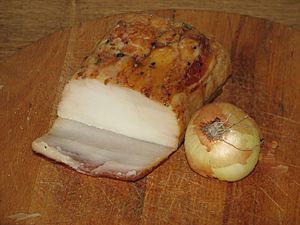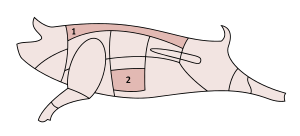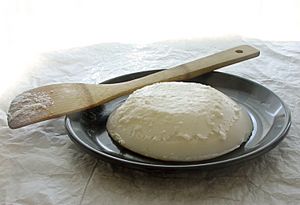Fatback facts for kids
Fatback is a special type of fat that comes from the back of a pig. It's the layer of fat found right under the pig's skin. Sometimes, the skin (called pork rind) is left on.
Fatback is known as "hard fat." This is different from the softer fat found inside the pig's belly. That softer fat is used to make a cooking oil called leaf lard.
You can melt down fatback to make a high-quality cooking oil called lard. It's also used to make salt pork. Small pieces of fatback are important for making sausages and other meat dishes.
Fatback is a key part of traditional charcuterie. This is a fancy word for preparing cured meats. In many European countries, fatback is used to make a special kind of bacon. This bacon has no muscle, just fat, and is considered a tasty treat.
Long ago, fatback was a basic cooking fat in Italy. This was especially true in places where olive trees didn't grow much. Over time, people started eating less of it. But it still gives a rich, real flavor to classic Italian dishes. Today, pancetta is often used instead.
Contents
What is Fatback Bacon?

Fatback can be made into slab bacon in many ways. These ways include soaking it in salty water (brine curing) or rubbing it with salt (dry curing). It can also be smoked or boiled. Usually, the skin is left on when making this bacon.
This type of fatback bacon is eaten widely across Europe. In Italy, it's called lardo. Famous examples include Valle d'Aosta Lard d'Arnad and Lardo di Colonnata.
In Ukraine, Russia, and other countries that were once part of the Soviet Union, it's called salo. In Hungary, it's known as szalonna. In Bulgaria, it's called slanina. It's very popular for cooking over a campfire in these places. In Germany, it's called Rückenspeck (back pork fat). It is one of two types of meat known as Speck there.
Fatback in Southern US Cooking
Fatback is a traditional part of southern US cooking. It's also found in soul food and the traditional cuisine of Quebec. In these areas, it's used to make fried pork rinds. These are known as cracklings, or oreilles de crisse in Quebec.
Fatback is also used to flavor stewed vegetables. These include leaf vegetables, green beans, and black-eyed peas. A common tasty treat is strips of heavily salted and fried fatback. Fatback was very popular in the South during the Great Depression. This was because it was a cheap piece of meat. In the southwestern United States, fried fatback is known by its Spanish name, chicharrón.
Fatback in Sausages
Fatback is an important ingredient in many traditional sausages. These include nduja, cudighi, and cotechino Modena.
Fatback in Cooking Techniques
In French cooking, very thin slices of fatback are used. They line the mold when making a terrine or pâté. Thin strips of fatback are also put under the skin of lean game birds before roasting. These methods are called barding and larding. In both cases, the fatback is used without the skin. Fatback is also used to make lardons, salt pork, and lard.
See also
 In Spanish: Grasa de cerdo para niños
In Spanish: Grasa de cerdo para niños





